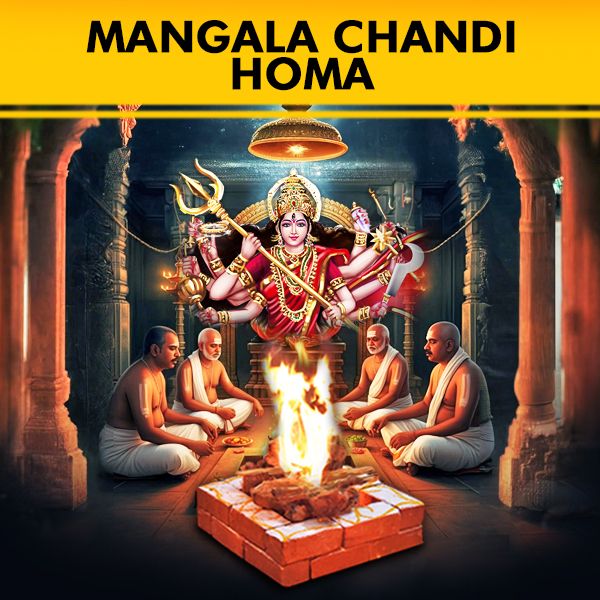Mangala Chandi Homam - Kumbakonam
Mangala Chandi Homam | Kumbakonam
Mangala Chandi Homam at Kumbakonam is a powerful Durga Saptashati ritual dedicated to Ashtabhuja Durga—the eight-armed form of the Divine Mother installed at Aduthurai near Kumbakonam by Kanchi Maha Periyava Sri Chandrashekharendra Saraswati Swamigal.
Conducted on the sacred banks of River Kaveri, this homam invokes Goddess Durga’s protection, grace, and blessings for prosperity and relief from planetary afflictions.
Benefits of Mangala Chandi Homam
- Removes Kuja Dosha and mitigates adverse Mars influences in the horoscope.
- Brings harmony in marriage and stability in relationships.
- Enhances strength, confidence, and victory in career and competition.
- Helps overcome financial obstacles and grants material abundance.
- Offers spiritual upliftment and divine protection from negative energies.
Mangala Chandi Homam - Kumbakonam
Mangala Chandi Homam performed at Kumbakonam is a highly sacred Vedic ritual dedicated to Goddess Durga performed by expert Pandits and Purohits from AstroPuja, to invoke Her blessings for protection, prosperity, and spiritual upliftment. This divine homam is conducted on the holy banks of the River Kaveri at Kumbakonam, one of the most revered spiritual centers in South India.
The ritual involves the recitation of Durga Saptashati, also known as Devi Mahatmya, where each Adhyaayam concludes with an offering of a blouse piece, neivedhyam, and Abhishekam to Ashtabhuja Durga—the eight-armed form of the Divine Mother.
Why Kumbakonam is Ideal for Chandi Homam?
The powerful deity Ashtabhuja Durga represents victory, protection, and compassion.
This sacred form of the Goddess, installed at Aduthurai near Kumbakonam by His Holiness Kanchi Maha Periyava Sri Chandrashekharendra Saraswati Swamigal, holds immense spiritual potency. She is depicted with eight hands holding divine weapons symbolizing Her control over all cosmic forces. Worship of Ashtabhuja Durga is believed to bestow courage, remove evil influences, and protect devotees from unseen adversities. Performing Mangala Chandi Homam in Her presence at Aduthurai strengthens the spiritual and astrological benefits manifold.
Mangala Chandi Homa Puja Vidhi
The Mangala Chandi Homam is performed by one experienced purohit following Vedic traditions and Devi Mahatmya chanting. The procedure includes:
- Sankalpa (Divine Intention): The devotee’s name, nakshatra, and gotra are recited to invoke personal blessings from the Goddess.
- Durga Saptashati Parayanam: The priest chants all 13 chapters of Durga Saptashati, each Adhyaayam representing a form and victory of the Goddess.
- Offering of Blouse Pieces: After every Adhyaayam, a blouse piece (vastram) is offered as a symbolic gesture of devotion to Goddess Chandika Devi.
- Neivedhyam and Abhishekam: Special food offerings and Abhishekam (ritual bathing) are performed to Ashtabhuja Durga using sacred substances like milk, honey, and sandal paste.
- Homam (Fire Ritual): The Agni Kunda is kindled, and sacred Durga mantras are chanted while offering ghee, herbs, and samagri to the fire, invoking the energy of Mahashakti.
- Poornahuti: The final offering symbolizes completion and surrender to the Divine Mother, concluding with Deeparadhana and Prasadam distribution.
Astrological and Spiritual Benefits of Mangala Chandi Homam
The Mangala Chandi Homam is particularly recommended for individuals facing Kuja Dosha, frequent failures, health issues, or marital discord. The energy of Goddess Durga helps balance planetary influences and remove karmic blocks.
Astrological and spiritual benefits include:
- Relief from Kuja Dosha: Calms the malefic effects of Mars and brings harmony in marital life.
- Protection from negative energies: Destroys evil influences, black magic, and planetary afflictions.
- Success and confidence: Strengthens one’s courage and ensures victory over enemies and competition.
- Financial growth and stability: Attracts prosperity and helps overcome debt or stagnation in career.
- Spiritual advancement: Enhances inner strength, self-discipline, and connection with divine feminine energy.
Importance of Performing Chandi Homam on Kaveri Banks
The banks of River Kaveri are known for their purifying energy and sacred vibrations. Performing Mangala Chandi Homam here allows devotees to draw from the river’s divine power that washes away sins and negativity. The combination of Devi worship and the Kaveri’s sanctity ensures the ritual yields amplified spiritual and material benefits. The calm and auspicious environment of Kumbakonam enhances the meditative experience, enabling devotees to receive Goddess Durga’s blessings in abundance.
Kumbakonam, also known as the Temple Town of South India, is sanctified by the confluence of sacred rivers and surrounded by ancient shrines of Lord Shiva, Vishnu, and Devi. The Kaveri River, flowing gracefully through this town, is believed to carry the divine vibrations of countless Vedic rituals performed along its banks for millennia. Performing Chandi Homam at Kumbakonam aligns the ritual energy with the natural cosmic flow, purifying karmic imbalances and magnifying the blessings of Goddess Durga. The presence of temples like Kasi Viswanathar, Mahamaham Tank, and Aduthurai’s Ashtabhuja Durga makes this region a spiritually charged center for Shakti Upasana.
Chandika Devi – The Embodiment of Shakti
Chandika Devi, the fierce yet compassionate form of Durga, represents divine justice and ultimate victory over darkness. The Durga Saptashati narrates Her glorious battles against Mahishasura, Shumbha, and Nishumbha—symbolizing triumph over ego, greed, and ignorance. When devotees perform Mangala Chandi Homam, they align their inner energies with Chandika’s power, gaining strength to overcome life’s struggles and achieve balance and positivity.
Kumbakonam holds a special place in the sacred traditions of Shakti worship, for it was here that the great scholar Bhaskararaya Makhin, one of the foremost exponents of Sri Vidya, composed his celebrated commentary — the Lalitha Sahasranama Bhaashyam. In this profound work, Bhaskararaya revealed the esoteric meanings behind each divine name of Goddess Lalitha Tripurasundari, interpreting them through the lens of Srividya and Chandi Upasana. The Lalitha Sahasranama and the Durga Saptashati (Chandi Patha) are deeply interconnected; both celebrate the victory of the Divine Mother over ignorance and negativity. While the Sahasranama glorifies Her transcendental, benevolent form, the Chandi extols Her fierce and protective aspect. Thus, performing Mangala Chandi Homam in Kumbakonam, the very land that nurtured Bhaskararaya’s divine scholarship, harmoniously unites devotion, knowledge, and empowerment under the grace of the Supreme Shakti.

